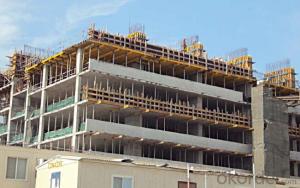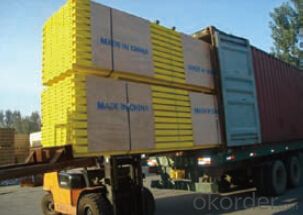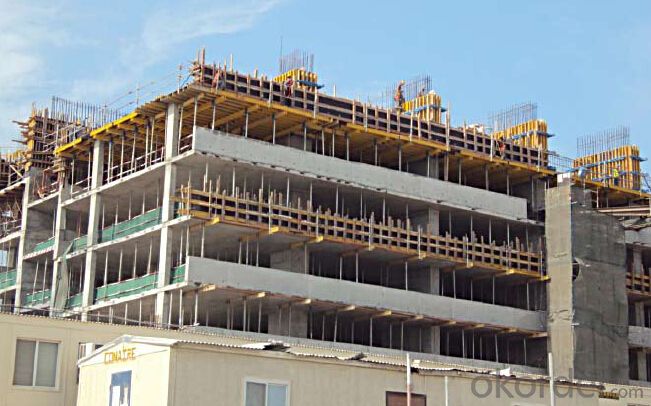Timber-beam Formwork and H20 for formwork and scaffolding system
- Loading Port:
- Tianjin
- Payment Terms:
- TT OR LC
- Min Order Qty:
- 50 m²
- Supply Capability:
- 1000 m²/month
OKorder Service Pledge
OKorder Financial Service
You Might Also Like
Characteristics:
◆ Standardized production lines.
Supply capability: 3000m/day, Lmax = 6600mm.
◆ Finger jointing of the flange and web, the strength of timber beam is highly improved.
Max. shearing force failure load:40KN
◆ Well treated to prevent from water penetration or erosion, so the service life maximally
extended.
Normally, CNBM timber beam H20 can be used for 4 to 5 years, the exact using time would
depend on maintenance & storage.
◆ Robust caps at the end of the girders protect against damages.
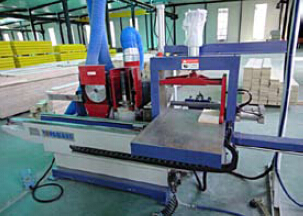
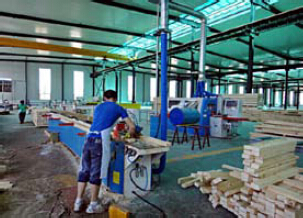

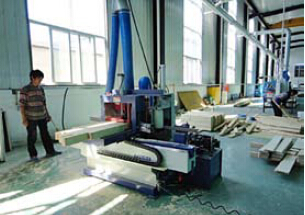
- Q: What are the main components of a steel formwork system?
- The main components of a steel formwork system typically include panels, connectors, clamps, pins, and wedges.
- Q: How does steel formwork help in achieving accurate dimensions and shapes?
- Steel formwork helps in achieving accurate dimensions and shapes by providing a rigid and stable structure that can withstand the pressure of the concrete during the pouring and curing process. Unlike traditional wooden formwork, steel formwork does not warp or bend, ensuring that the dimensions and shapes remain consistent throughout the construction process. The steel panels used in formwork are precision-manufactured, allowing for tight tolerances and accurate measurements. These panels can be easily adjusted and interconnected, allowing for flexibility in creating various shapes and sizes. Additionally, steel formwork is highly durable and can be reused multiple times, ensuring that the dimensions and shapes achieved in one project can be replicated accurately in subsequent projects. This reusability not only saves time and money but also ensures consistent results. The strength and stability of steel formwork also prevent any deformation or movement of the concrete during the pouring and curing stages. This eliminates the risk of inaccuracies or distortions in the final dimensions and shapes of the concrete elements. Overall, steel formwork provides a reliable and efficient solution for achieving accurate dimensions and shapes in construction projects. Its strength, durability, and precision make it an ideal choice for ensuring consistent and high-quality results.
- Q: How does steel formwork contribute to the overall durability of the concrete structure?
- The overall durability of a concrete structure is significantly enhanced by steel formwork in various ways. To begin with, the presence of steel formwork ensures that the concrete is poured and shaped within a strong and rigid framework. As a result, the concrete receives proper support during the curing process, effectively preventing any deformation or collapse that could compromise the integrity of the structure. Furthermore, steel formwork exhibits a high level of resistance against the corrosive properties of concrete, in which alkaline substances can gradually erode other materials. This resistance contributes to the stability and intactness of the formwork throughout the construction phase, thereby preserving the shape and dimensions of the concrete components. In addition, the utilization of steel formwork enables precise and accurate construction, leading to a concrete structure with consistent dimensions and smooth finishes. This precision significantly reduces the likelihood of structural weaknesses or flaws in the concrete, ultimately enhancing its overall durability. Moreover, the reusability of steel formwork renders it a cost-effective choice for construction projects. By repeatedly employing steel formwork, the durability of the concrete structure is further improved, as the formwork maintains its strength and stability across multiple applications. To conclude, the pivotal role of steel formwork in augmenting the overall durability of a concrete structure cannot be overstated. Its strength, resistance to corrosion, precision, and reusability all contribute to effectively supporting the concrete, accurately constructing it, and enabling it to withstand external forces. As a result, a long-lasting and robust structure is achieved.
- Q: Are there any specific considerations for using steel formwork in areas with high wind loads?
- Yes, there are several specific considerations for using steel formwork in areas with high wind loads. Firstly, the design of steel formwork should be able to withstand the increased wind pressure to ensure the stability of the structure. Reinforcements and additional bracing may be necessary to enhance the formwork's resistance against wind forces. Additionally, proper anchoring and securing of the formwork system becomes crucial to prevent it from being dislodged or damaged by strong winds. Regular inspection and maintenance are also important to identify and address any potential weaknesses or damages caused by the high wind loads.
- Q: Is steel formwork more environmentally friendly than other types of formwork?
- Steel formwork is generally considered to be more environmentally friendly than other types of formwork for several reasons. Firstly, steel is a highly durable material that can be reused multiple times, reducing the need for constant production of new formwork materials. This helps in conserving natural resources and reducing waste. Moreover, steel formwork has a longer lifespan compared to other materials like timber or plywood, which often degrade over time and need to be replaced frequently. This longevity reduces the overall consumption of formwork materials and the associated environmental impact. Additionally, steel formwork can be easily recycled at the end of its life, further reducing waste and minimizing the carbon footprint. The recycling process for steel is highly efficient and requires much less energy compared to the production of new steel, resulting in significant energy savings and reduced greenhouse gas emissions. Furthermore, steel formwork is resistant to moisture and other elements, reducing the need for chemical treatments to protect it from decay or damage. This reduces the release of harmful substances into the environment, making steel formwork a safer and more sustainable option. However, it's important to note that the environmental impact of steel formwork can also depend on factors such as the manufacturing processes used, transportation distances, and the specific project requirements. Therefore, it is crucial to consider the entire life cycle of the formwork and make informed decisions based on the specific circumstances to ensure the most environmentally friendly choice.
- Q: How does steel formwork handle formwork stripping?
- Steel formwork is highly durable and strong, allowing it to handle formwork stripping efficiently. The steel panels used in steel formwork systems are designed to be easily removed after the concrete has cured. This is typically achieved by using specialized tools such as formwork release agents, wedges, or hydraulic systems. Steel formwork's robust construction ensures it can withstand the pressure exerted during the stripping process, making it a reliable and effective choice for handling formwork stripping.
- Q: What are the different safety certifications and standards for steel formwork?
- There are several safety certifications and standards that apply to steel formwork. These certifications and standards ensure that the steel formwork meets specific safety requirements and can be used safely in construction projects. Some of the different safety certifications and standards for steel formwork include: 1. ISO 9001: This certification ensures that the steel formwork manufacturer has implemented a quality management system and meets the necessary quality standards. It focuses on the overall quality and reliability of the product. 2. ISO 3834: This certification ensures that the welding processes used in the production of steel formwork are carried out in accordance with specific quality requirements. It emphasizes the welding quality and ensures that the welds are strong and durable. 3. EN 12812: This European standard provides guidelines for the design and performance of formwork systems, including steel formwork. It covers aspects such as load-bearing capacity, stability, and safety requirements for formwork systems. 4. OSHA: The Occupational Safety and Health Administration sets safety standards for the construction industry in the United States. While there are no specific certifications for steel formwork, compliance with OSHA standards is essential to ensure a safe working environment for construction workers using steel formwork. 5. BS 5975: This British standard provides recommendations for temporary works, including formwork systems. It covers aspects such as design, erection, use, and dismantling of formwork systems, ensuring safety throughout the construction process. 6. ACI 347: This American Concrete Institute standard provides guidelines for the design, construction, and maintenance of concrete structures. It includes recommendations for formwork systems, including steel formwork, to ensure their safety and effectiveness in supporting the concrete during construction. These certifications and standards play a crucial role in ensuring that steel formwork is manufactured and used safely in construction projects. By adhering to these certifications and standards, construction companies can ensure the safety of their workers and the quality of their structures. It is important for construction professionals to be aware of these certifications and standards and ensure compliance with them when using steel formwork.
- Q: How does steel formwork affect the construction schedule?
- The construction schedule can be significantly impacted by steel formwork. One of the main benefits of using steel formwork is its ability to provide a high level of stability and strength, enabling faster construction processes. This results in reduced overall construction time compared to traditional formwork methods. Moreover, steel formwork is highly durable and can be used multiple times, making it suitable for future projects. This reduces the time and cost associated with acquiring and assembling new formwork for each project, further enhancing the efficiency of the construction schedule. In addition, steel formwork allows for precise and accurate construction, resulting in a higher quality finished product. This minimizes the need for rework and corrections, ultimately saving time and ensuring that the project stays on schedule. Furthermore, steel formwork is known for its flexibility and adaptability. It can be easily adjusted and modified to accommodate design or construction changes. This promotes a smoother workflow and minimizes delays that may arise from design alterations. However, it is important to note that the initial setup and installation of steel formwork may require more time and resources compared to other formwork systems. The design and fabrication process for steel formwork can be more complex, necessitating careful planning and coordination. Therefore, it is crucial to consider these factors during the project planning phase to ensure that the construction schedule is not negatively affected. Overall, steel formwork can significantly expedite the construction schedule by offering strength, durability, precision, and adaptability. However, it is essential to thoroughly evaluate project requirements and available resources to optimize the use of steel formwork and minimize potential disruptions to the construction schedule.
- Q: Can steel formwork be used for underground culverts?
- Yes, steel formwork can be used for underground culverts. Steel formwork is known for its durability, strength, and ability to withstand heavy loads and pressure. This makes it suitable for constructing underground culverts, which are designed to carry water, sewage, or other fluids below the ground surface. Steel formwork provides a rigid structure that can withstand the weight of the soil and any traffic loads above it, ensuring the stability and longevity of the culvert. Additionally, steel formwork is versatile and can be easily customized to accommodate different sizes and shapes of culverts. Overall, steel formwork is a reliable and efficient choice for constructing underground culverts.
- Q: How does steel formwork affect the overall waste management of the construction process?
- Steel formwork can have a positive impact on the overall waste management of the construction process. Unlike traditional timber formwork, steel formwork can be reused multiple times, reducing the amount of waste generated during construction. This not only minimizes the need for raw materials but also decreases the amount of waste that needs to be disposed of. Additionally, steel formwork is more durable and resistant to damage, further extending its lifespan and reducing waste. Overall, the use of steel formwork in construction can contribute to a more sustainable and efficient waste management system.
Send your message to us
Timber-beam Formwork and H20 for formwork and scaffolding system
- Loading Port:
- Tianjin
- Payment Terms:
- TT OR LC
- Min Order Qty:
- 50 m²
- Supply Capability:
- 1000 m²/month
OKorder Service Pledge
OKorder Financial Service
Similar products
Hot products
Hot Searches
Related keywords

